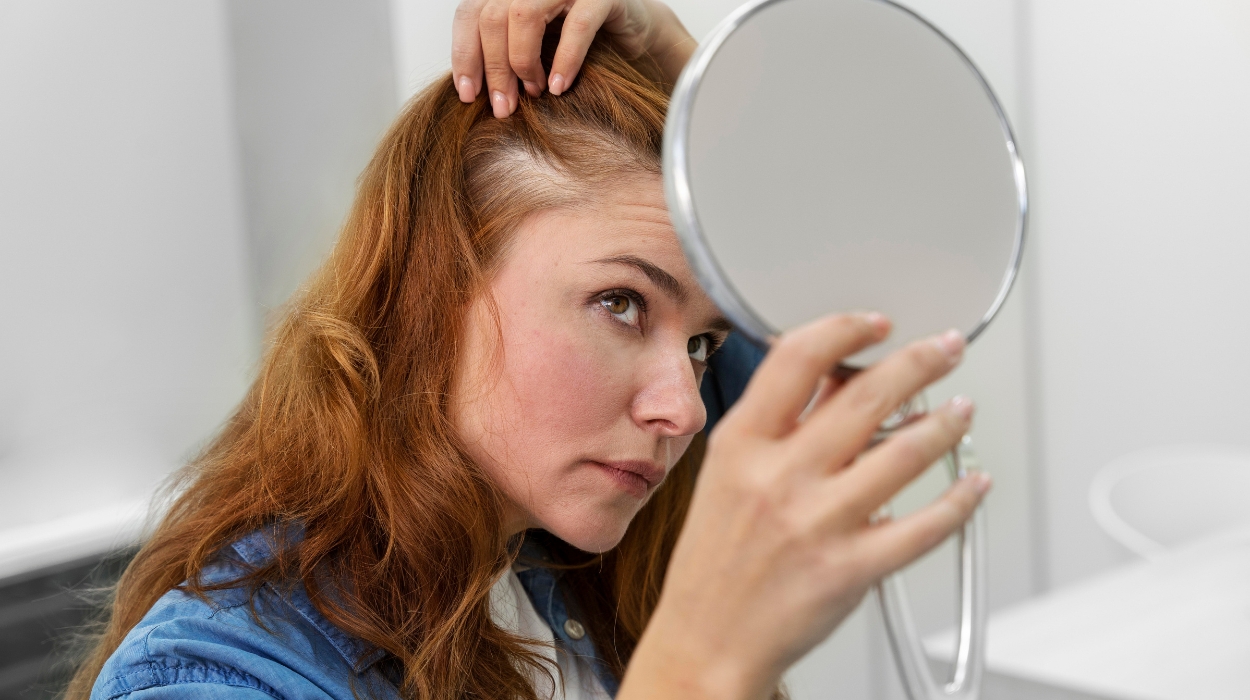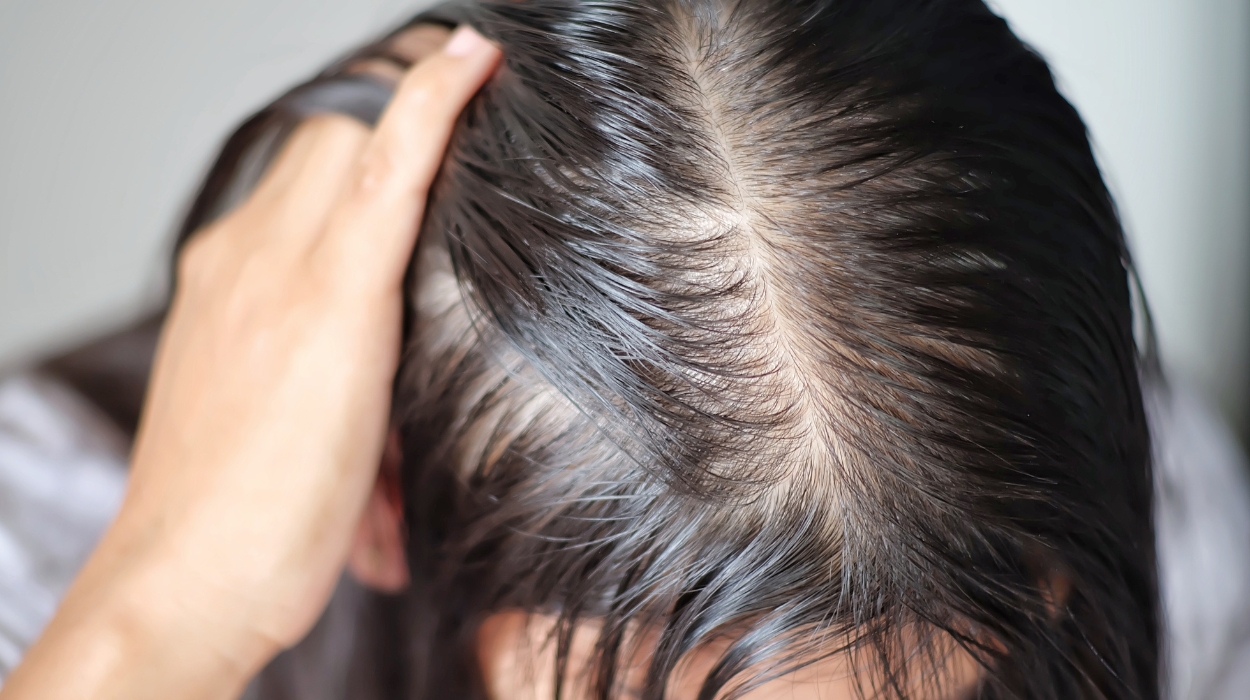 Expert's opinion
Expert's opinion
Expert's opinion
The article is a subjective view on this topic written by writers specializing in medical writing.
It may reflect on a personal journey surrounding struggles with an illness or medical condition, involve product comparisons, diet considerations, or other health-related opinions.
Although the view is entirely that of the writer, it is based on academic experiences and scientific research they have conducted; it is fact-checked by a team of degreed medical experts, and validated by sources attached to the article.
The numbers in parenthesis (1,2,3) will take you to clickable links to related scientific papers.
Why Is My Hair Not Growing: Common Reasons & How To Fix In 2024

Hair health is vital to some people. Women, in particular, find that the appearance of their hair symbolizes femininity and overall health. Thus, they may ask themselves: why is my hair not growing? Whether it is caused by genetics or a vitamin deficiency, people who experience this kind of thing may wonder how to fix stunted hair growth.
Fortunately, it is possible to reactivate your hair’s growth cycle, but the exact method to fix this will depend on the cause.
Reasons Why Your Hair Stops Growing
Research suggests that the following reasons may be why your hair isn’t growing:
- Genetics and age.
- Diet.
- Hair breakage.
- Stress.
Why Is My Hair Not Growing? Four Common Reasons
Does your hair stop growing? In some cases, hair growth can become dormant and stuck in the telogen/resting phase, which prevents it from reaching the anagen/growth stage again.
Genetics And Age

There may be medical or mental health reasons why hair won’t grow. Unfortunately, if this is the case, it may not be something you have much control over when it comes to hair growth.
Hair growth and hair loss[1] are mainly genetic,[2] and your genetic makeup determines everything about your hair, from its density and color to how quickly it can grow. As a result, hair growth can be hindered or outright stopped by hereditary disorders or gene abnormalities.
Your age can affect hair growth. As you get older, your hair’s growth cycle shortens tremendously. This is natural with aging.
Diet
Your diet[3] can – quite literally – make or break your hair growth cycle. Any form of nutrient deficiency can impact hair growth, such as inadequate intake of calories, protein, and/or micronutrients.
Acute telogen effluvium is a well-known effect of sudden weight loss or decreased protein intake. This insufficient intake is important to realize, as ingesting sufficient protein allows hair to grow stronger.
Hair Breakage
Depending on how you care for your hair’s appearance, it is more likely to break off faster than it can grow. Various common hair care methods can damage your hair strands and lead to breakage in the form of split ends. These methods include, but are not limited to, the following:
- Over-processing your hair via perms and artificial hair coloring can leave hair cuticles weak and brittle.
- Using curling/straightening irons or any other hair care tools that utilize heat can damage the hair’s structure by burning it.
- Being too rough when styling your hair. Some examples include brushing with too much force, hairstyles that tug too strongly on your hair follicles, or using uncovered hair elastics.
Stress
One study shows that even small amounts of stress can lead to reduced hair growth[4] and, in some cases, hair loss. Stress can cause the body to release certain stress hormones known to contribute to the excessive shedding of hair. The more stress someone experiences, the less their hair will grow.
What Is A Hair Growth Cycle?
Hair is formed through the rapid division and differentiation of stem cells starting at the hair follicles. The hair growth cycle divides into three phases: anagen, catagen, and telogen
During the anagen phase, the hair follicle produces the hair fiber you see on your head. The follicle is then differentiated before the hair shaft appears on the surface of your skin. This phase can last for several years.
During the catagen phase, the hair follicle loses about one-sixth of its standard diameter and forms a club hair. This hair follicle can appear more noticeable in those with hypo/hyperthyroidism, stress, and vitamin deficiencies. This phase lasts from a few days to a few weeks. At this stage, the hair follicle holds the club hair in place.
During the telogen or resting phase, the hair follicle grows dormant. In other words, your hair won’t grow in this growth cycle phase. The length of this phase varies depending on where the hair is, but it can last up to one year on your scalp. Excessive shedding may occur during this phase, with an average loss of 100 strands daily.
Ways To Make Your Hair Grow Faster
Eat A Healthy And Balanced Diet

If nutritional deficiencies hinder your hair growth, the best way to fix these chemical imbalances to grow your hair out is by eating foods high in the nutrients that you lack. Foods high in zinc, vitamin C, vitamin B7, and iron are more likely to restore these deficiencies; thus, helping your hair grow while reducing the likelihood of hair loss.
If, for any reason, it is hard to incorporate more of a certain nutrient into your diet, consider taking products that can be considered hair supplements that provide even more health benefits. Remember, a poor diet can facilitate a nutrient deficiency.
Use Essential Oils
While plenty of products are marketed as natural hair growth oils, they don’t actually make hair magically grow. Instead, the composition of these essential oils can boost your hair’s ability to grow by stimulating blood circulation in the scalp and enhancing the growth rate of your luscious locks.
Some examples of natural ingredients that have been scientifically[5] proven to help stimulate hair growth are peppermint, rosemary, and castor oil.
Use Topical Products
Certain OTC topical hair products, such as Minoxidil, can help treat forms of hair loss by promoting hair growth. Such topical products have been shown to reduce the rate of hair loss while increasing the rate of hair growth.
Other Ways To Get Length
While these are not necessarily things you can do to promote long hair growth, these styling tips can reduce the likelihood of hair loss or dormant growth.
Avoid Hair Treatments Involving Chemicals Or Heat
As discussed earlier, various styling methods can damage your hair and hinder its natural ability to grow. Dialing back on chemical treatments, including certain hair dyes and bleach, makes your hair less likely to break and stop growing.
Excessive heat styling via curling irons and the like is just as damaging to your hair, albeit in a different way from chemical dyes. However, there are very few cases where heat is needed. In these cases, it is recommended to keep heat styling to a minimum, decrease the temperature if possible, and use a heat protectant.
Get Regular Trims
Women may often ask themselves, why is my hair not growing after a haircut? Much to their amazement, however, is the fact that regular trimming is a hair care routine that keeps hair healthy enough to grow by leaving your split ends behind.
Of course, cutting your hair short doesn’t directly make your hair grow longer and faster. Getting rid of split ends can prevent hair loss and give the appearance of fast-growing hair, which may be enough for some women.
When To See A Doctor
It is best to see a doctor if you have any concerns regarding reduced hair growth, including unexplained hair loss. Seeing a physician is recommended if you also notice signs of severely damaged hair or other significant changes that may be impacting growth.
A doctor may determine whether you have any hereditary disorders or vitamin deficiencies that may be affecting your hair’s growth cycle. If a new hair growth process is impeded by a medical condition or a poor diet, they may be able to treat the underlying cause, thus promoting hair regrowth.
The Bottom Line
The average person’s hair grows about half an inch per month, but this might not be the case for everyone. Stunted hair growth may not seem like a problem for some people, but others with hindered growth cycles may wonder why their hair won’t grow past their shoulders. The possible causes of stunted hair growth can vary from genetic abnormalities to nutrition deficiencies to simply just mistreatment of your hair.
Regardless of the cause, however, various hair growth devices and treatments can remedy slow hair growth and bring you more confidence in your appearance. Of course, none of the treatments or tips mentioned here are magical solutions for long and luscious hair. They simply promote healthy hair growth and make it more likely to achieve your ideal hair length.
+ 5 sources
Health Canal avoids using tertiary references. We have strict sourcing guidelines and rely on peer-reviewed studies, academic researches from medical associations and institutions. To ensure the accuracy of articles in Health Canal, you can read more about the editorial process here
- Medlineplus.gov. (2023). Aging changes in hair and nails: MedlinePlus Medical Encyclopedia. [online] Available at: https://medlineplus.gov/ency/article/004005.htm.
- Nuriye Gokce, Neslihan Basgoz, Sercan Kenanoglu, Hilal Akalin, Yusuf Ozkul, Mahmut Cerkez Ergoren, Beccari, T., Bertelli, M. and Munis Dundar (2022). An overview of the genetic aspects of hair loss and its connection with nutrition. [online] 63(2 Suppl 3), pp.E228–E238. doi:https://doi.org/10.15167/2421-4248/jpmh2022.63.2s3.2765.
- Guo, E.L. and Katta, R. (2017). Diet and hair loss: effects of nutrient deficiency and supplement use. [online] pp.1–10. doi:https://doi.org/10.5826/dpc.0701a01.
- National Institutes of Health (NIH). (2021). How stress causes hair loss. [online] Available at: https://www.nih.gov/news-events/nih-research-matters/how-stress-causes-hair-loss.
- JC; (2020). The Use of Natural Ingredients in the Treatment of Alopecias with an Emphasis on Central Centrifugal Cicatricial Alopecia: A Systematic Review. The Journal of clinical and aesthetic dermatology, [online] 13(8). Available at: https://pubmed.ncbi.nlm.nih.gov/33178378/.



